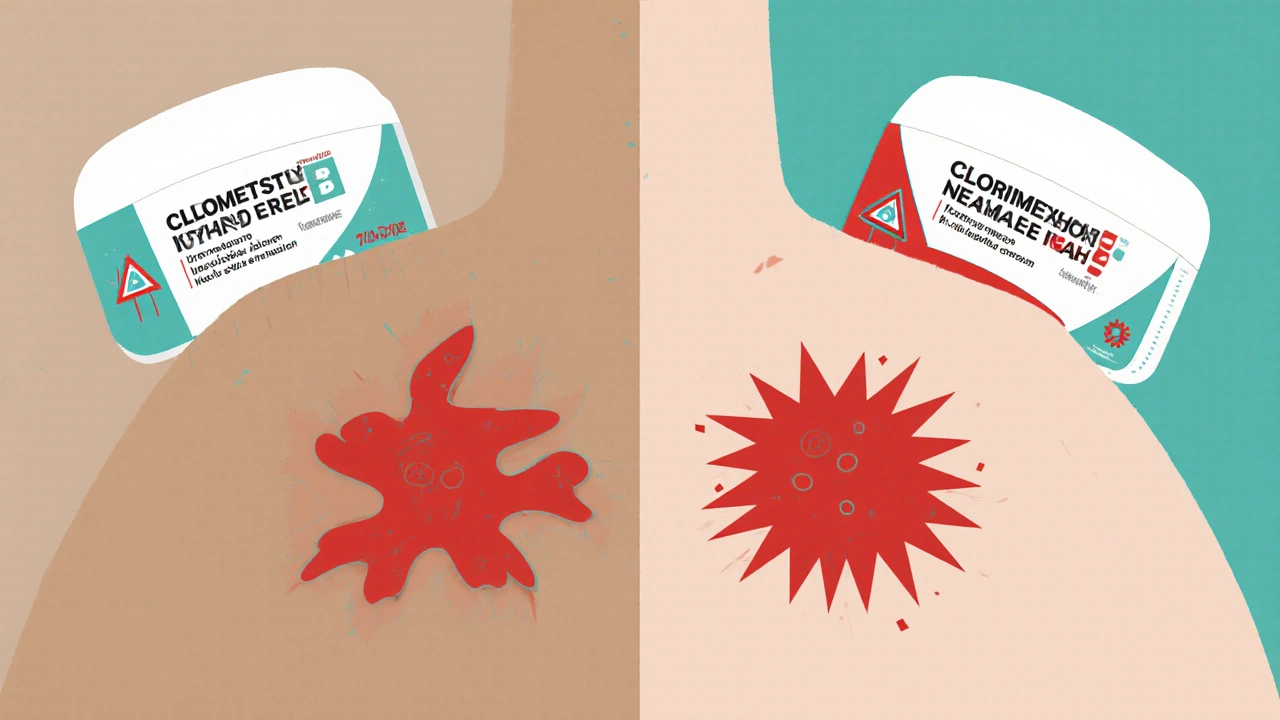
Skin Condition Treatment Guide
Skin Condition Assessment
Answer these questions to get a personalized treatment recommendation
Candid B Lotion is a common prescription for skin conditions that involve both fungal infections and inflammation. It combines two active ingredients: beclometasone, a mild corticosteroid, and clotrimazole, an antifungal. This combo works well for rashes that are itchy, red, and fungal in origin-like athlete’s foot, jock itch, or fungal eczema. But it’s not the only option out there. Many people wonder: are there better, cheaper, or safer alternatives? The answer depends on your exact symptoms, skin type, and whether you need just antifungal action, just anti-inflammatory, or both.
What Candid B Lotion Actually Does
Candid B Lotion isn’t just a moisturizer or a plain antifungal. It’s a two-in-one treatment. The clotrimazole kills fungi like Candida and dermatophytes that cause skin infections. The beclometasone reduces swelling, redness, and itching caused by your body’s immune response to the infection. This dual action makes it effective for conditions where fungus triggers inflammation, like intertrigo (rashes in skin folds) or seborrheic dermatitis with fungal overgrowth.
But here’s the catch: steroid creams like beclometasone shouldn’t be used long-term. Using them for more than two weeks on the face, groin, or underarms can thin the skin, cause stretch marks, or even make fungal infections worse by suppressing your skin’s natural defenses. That’s why Candid B Lotion is usually prescribed for short bursts-7 to 14 days-until the infection clears.
Alternatives Without Steroids
If you’re worried about steroid side effects-or your doctor told you to avoid them-there are strong antifungal-only options. These work just as well for pure fungal infections without inflammation.
- Clotrimazole 1% cream (brand names: Lotrimin, Canesten): This is the same antifungal found in Candid B Lotion, but without the steroid. It’s available over-the-counter and works well for athlete’s foot, ringworm, and yeast rashes. Apply twice daily for 2-4 weeks.
- Miconazole 2% cream (Micatin, Monistat-Derm): Another OTC antifungal that’s effective against Candida. Some people find it less irritating than clotrimazole, especially on sensitive skin.
- Terbinafine cream (Lamisil): This targets dermatophytes more directly than clotrimazole. It’s often recommended for stubborn athlete’s foot and nail fungus. Studies show it clears infections faster than azole antifungals like clotrimazole in some cases.
- Econazole 1% cream: A potent antifungal that’s often used when other treatments fail. It’s available by prescription and has strong activity against Candida.
These options are safer for long-term use on sensitive areas. If your rash is just fungal-no severe redness or swelling-they’re often the better first choice.
Alternatives With Steroids
If you need both antifungal and anti-inflammatory power, but Candid B Lotion isn’t working or isn’t available, here are other combination creams:
- Clioquinol and Hydrocortisone (Vioform-HC): This combo fights fungi and reduces inflammation. Clioquinol is less common now due to safety concerns in some countries, but it’s still used in Australia and parts of Asia. It’s effective for infected eczema.
- Hydrocortisone and Miconazole (Dermazol, Lotriderm): Similar to Candid B, but uses hydrocortisone instead of beclometasone. Hydrocortisone is weaker, so it’s better for mild cases or sensitive skin like the face or baby skin. Not as strong for severe inflammation.
- Beclomethasone and Ketoconazole (Keto-B): This is almost identical to Candid B, but swaps clotrimazole for ketoconazole. Ketoconazole has broader antifungal coverage and is more effective against certain yeasts. Some dermatologists prefer it for recurrent fungal infections.
Beclometasone is stronger than hydrocortisone but weaker than clobetasol. That makes Candid B a good middle-ground option. If your rash is really inflamed, you might need something stronger-but only for a few days.
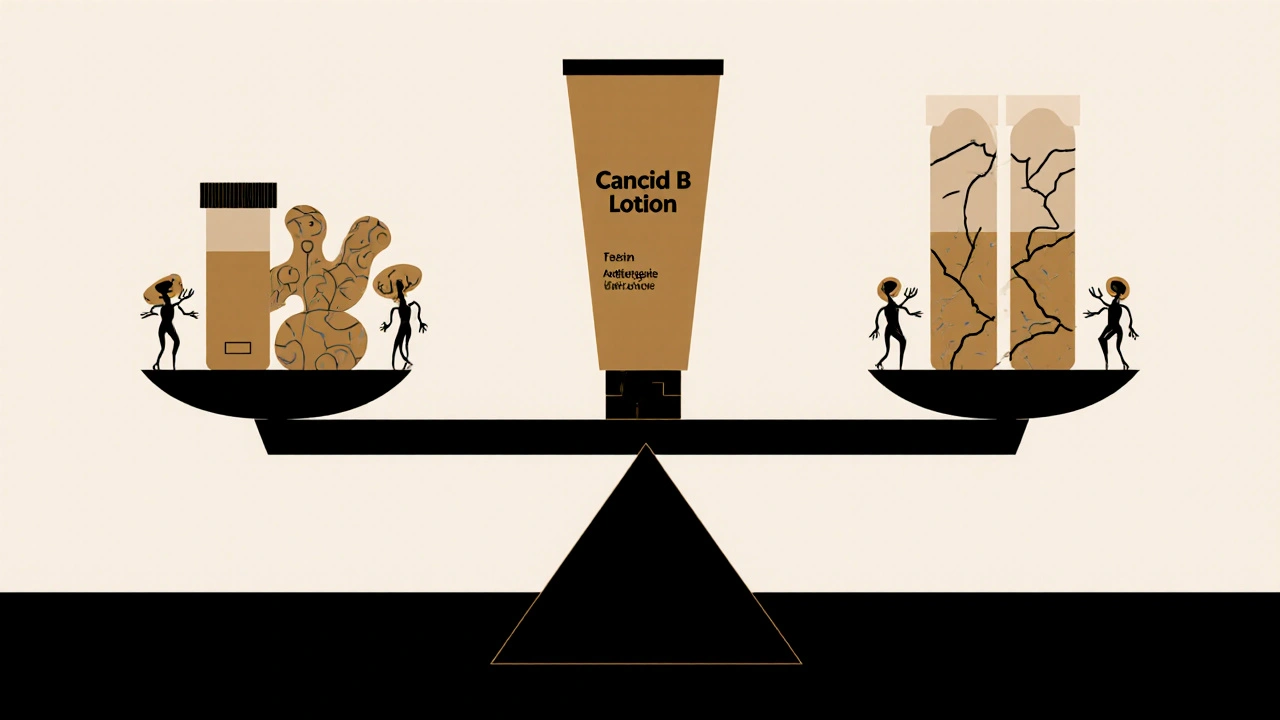
When to Avoid Steroid-Antifungal Combos
Not every itchy rash needs a steroid. Here’s when these creams can do more harm than good:
- Acne: Steroids can trigger or worsen acne. Don’t use Candid B on pimples or oily skin.
- Herpes or viral rashes: Steroids suppress immune response. Using them on cold sores or chickenpox can make the infection spread.
- Undiagnosed rashes: If you’re not sure what’s causing the itch, get it checked. A bacterial infection like impetigo won’t respond to antifungals and needs antibiotics.
- Long-term use: More than 2 weeks on thin skin areas? Risk of skin atrophy, discoloration, or rebound inflammation.
Many people use these creams for months because the itching stops quickly. But the fungus might still be there, hiding under the steroid’s suppression. That’s why relapse is common.
Cost and Availability
In Australia, Candid B Lotion is usually prescription-only. A 30g tube costs around $15-$25 with a PBS subsidy. Over-the-counter clotrimazole cream (1%) costs $8-$12 for 30g. Terbinafine cream is $18-$22. Combination creams like Keto-B or Lotriderm are usually more expensive than single-agent options.
If you’re paying full price, buying plain clotrimazole and a separate low-strength hydrocortisone (0.5-1%) can be cheaper than Candid B. You can apply them together-wait 15 minutes between applications-to mimic the combo effect without paying for the branded product.
Real-World Experience: What Works Best
From dermatology clinics in Sydney, here’s what’s seen most often:
- For jock itch with mild redness: Clotrimazole alone works 90% of the time. No need for steroid.
- For eczema flare-ups with fungal overgrowth: Candid B or Keto-B for 7-10 days, then switch to moisturizer and antifungal maintenance.
- For persistent athlete’s foot: Terbinafine cream for 4 weeks beats clotrimazole in 8 out of 10 cases.
- For facial rashes: Avoid beclometasone entirely. Use hydrocortisone 1% + miconazole only if prescribed.
One patient came in with a recurring rash between her toes. She’d been using Candid B for months because it "fixed it fast." But every time she stopped, it came back. We switched her to terbinafine cream for 6 weeks. No steroid. She hasn’t had a recurrence in 11 months.

How to Choose the Right Option
Ask yourself these three questions:
- Is the rash just fungal? (flaky, ring-shaped, itchy but not swollen) → Go with clotrimazole or terbinafine alone.
- Is it red, swollen, and very itchy? → A steroid-antifungal combo like Candid B for up to 10 days.
- Is this on your face, groin, or under a baby’s diaper? → Use the weakest steroid possible (hydrocortisone 1%) or skip steroids entirely.
Also, check the expiration date. Antifungal creams lose potency after 12-18 months. If it’s been sitting in your bathroom for years, toss it.
What to Do If Nothing Works
If your rash doesn’t improve after 2 weeks of proper treatment, see a doctor. You might have:
- A bacterial infection (needs antibiotics)
- A different fungus (like Malassezia, common in dandruff and seborrhea)
- An allergic reaction to the cream itself
- A systemic condition like psoriasis or diabetes that’s making skin infections harder to treat
Don’t keep switching creams. Keep a photo of the rash and note when it started, what you’ve tried, and whether it’s spreading. That helps your doctor diagnose faster.
Can I use Candid B Lotion for a yeast infection on my skin?
Yes, Candid B Lotion is effective for fungal yeast infections like Candida on the skin, especially in warm, moist areas like under the breasts, armpits, or groin. The clotrimazole kills the yeast, and the beclometasone reduces the redness and itching. But use it only for 7-10 days. Long-term use can make the infection worse or cause skin thinning.
Is Candid B Lotion better than Lotriderm?
Candid B and Lotriderm are very similar-both combine an antifungal with a steroid. Candid B uses beclometasone and clotrimazole; Lotriderm uses betamethasone and clotrimazole. Betamethasone is stronger than beclometasone, so Lotriderm works faster on severe inflammation. But it also carries a higher risk of side effects. Candid B is a safer choice for mild to moderate cases or sensitive skin.
Can I use Candid B Lotion on my face?
No, not unless your doctor specifically says so. The skin on your face is thin and sensitive. Beclometasone can cause acne, redness, or permanent skin thinning if used there. For facial fungal rashes, use a low-strength hydrocortisone (0.5-1%) with miconazole instead, and only for 5-7 days.
What’s the best over-the-counter alternative to Candid B Lotion?
The best OTC alternative is plain clotrimazole 1% cream for fungal-only cases. If you need anti-inflammatory help too, combine it with a separate 1% hydrocortisone cream. Apply the antifungal first, wait 15 minutes, then apply the hydrocortisone. This mimics Candid B without the brand cost. Terbinafine cream is also a strong OTC option for stubborn fungal infections.
How long should I use Candid B Lotion?
Use Candid B Lotion for no more than 7 to 14 days. Most fungal infections clear up in 5-7 days. If you still have symptoms after two weeks, stop using it and see a doctor. Continuing beyond this increases the risk of side effects like skin thinning, discoloration, or rebound inflammation. Don’t use it as a long-term moisturizer.
Final Takeaway
Candid B Lotion is a useful tool, but it’s not the only tool-and not always the best one. For simple fungal rashes, plain antifungals like clotrimazole or terbinafine work just as well and are safer. For inflamed, stubborn cases, Candid B or similar combos are helpful, but only for short bursts. Always treat the cause, not just the symptoms. And if you’re unsure, get it checked. Skin rashes can look similar but need very different treatments.



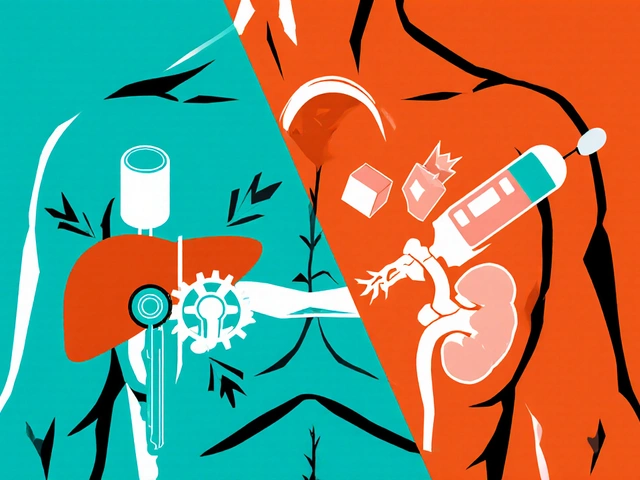
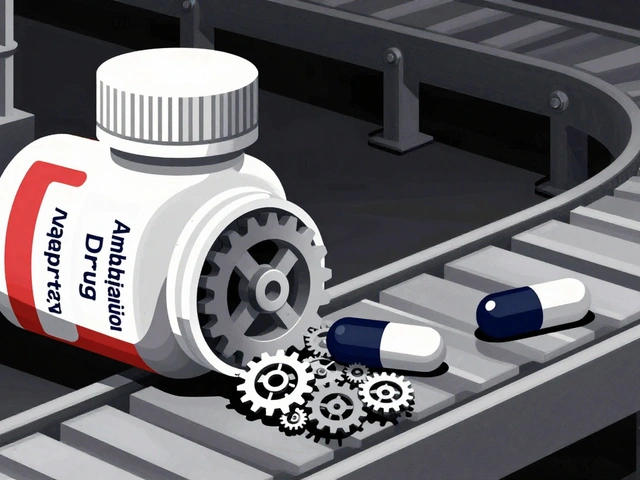


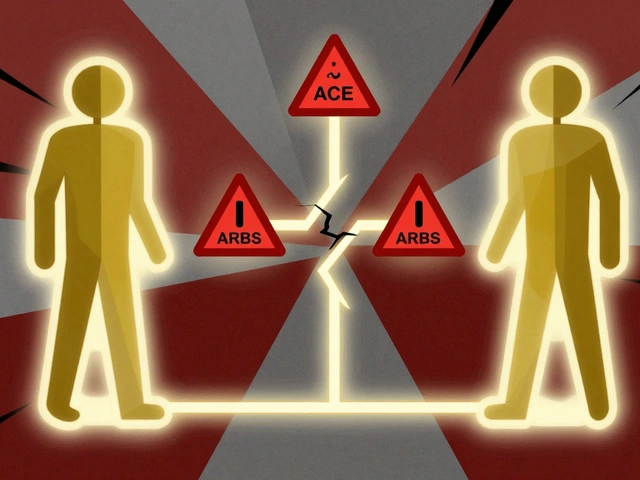
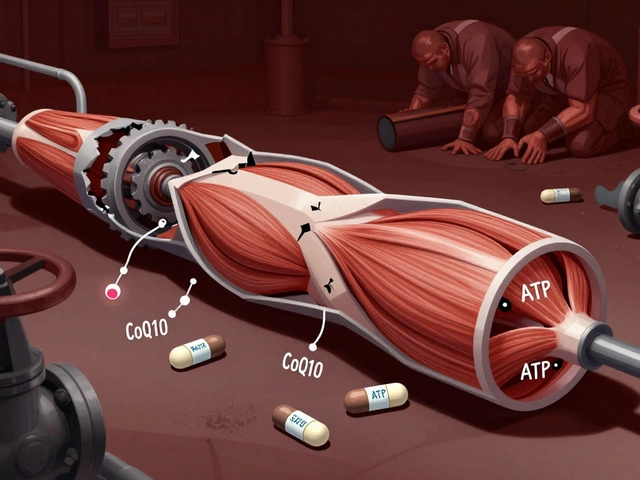
11 Comments
Really appreciate this breakdown. I’ve been using clotrimazole alone for my jock itch and it’s held up fine-no need to bring steroids into the mix unless it’s truly inflamed. Learned something new about terbinafine being faster for athlete’s foot. Thanks for the clarity.
OMG I’ve been using Candid B for 8 months straight because it "just works" and now I’m scared?? My dermatologist never told me about skin thinning!! I think I’m in crisis mode now 😭
Good call on the expiration date tip 🙌 I had a 3-year-old tube of clotrimazole in my bathroom cabinet-tossed it today. Also, applying antifungal first, then hydrocortisone after 15 mins? Genius. So many people just slap them on together and wonder why it doesn’t work.
While I appreciate the clinical tone, this is a textbook example of overcomplicating a simple issue. Candid B is a reliable, proven formulation. If you’re using OTC antifungals for months on end, you’re not treating the root cause-you’re just masking it. The steroid component is not the villain here; ignorance is. Stop playing DIY dermatologist and consult a professional.
Wow. So after all this, the answer is... just don’t use steroids? LMAO. I’ve been using Candid B for my "fungal eczema" since 2020. It’s literally my moisturizer now. What’s the worst that could happen? My skin looks like tissue paper? Cool. At least it’s not itchy.
This is one of the most balanced and practical guides I’ve read on this topic. The distinction between fungal-only and inflamed fungal rashes is critical-and so often overlooked. I’ve seen patients use steroid-antifungal combos for years because the itch goes away, then wonder why it comes back worse. The 7–14 day window is non-negotiable. Thank you for emphasizing that.
Of course the Aussies are telling us to avoid steroids. Next they’ll say we should stop using sunscreen because it’s "bad for the environment." This is why America still leads in medical innovation-because we don’t overthink simple fixes. Candid B works. Use it. Move on.
It is, regrettably, a matter of profound regret that such a well-structured exposition on the pharmacological nuances of topical corticosteroid-antifungal synergism should be met with such a cacophony of amateurish misinterpretations on this platform. One must, alas, lament the erosion of clinical literacy in the digital age. 🇬🇧
Let’s be real-most people don’t care about the science. They just want the itch to stop. That’s why Candid B sells. But here’s the thing: if you’re using it for more than two weeks, you’re not treating a fungal infection-you’re treating your own laziness. I’ve had patients who used it for years, then came back with skin that looked like crumpled parchment and a fungal infection that had spread to their thighs. The steroid didn’t cure them. It just bought them time to ignore the problem. The real solution? Consistency. Patience. And sometimes, just using plain clotrimazole for six weeks. No drama. No steroids. Just results.
wait so i can just buy clotrimazole and hydrocortisone separately and use them together?? i was gonna buy candid b but it was $25 and i thought that was insane?? this is a game changer 😭 thank you!!
Why are you all overthinking this? I’ve used Candid B for years. My skin’s fine. My doctor never said anything. You people are just scared of anything that has "steroid" in it. Next you’ll be saying ibuprofen causes kidney damage. It’s not a conspiracy-it’s medicine. Stop being so paranoid.